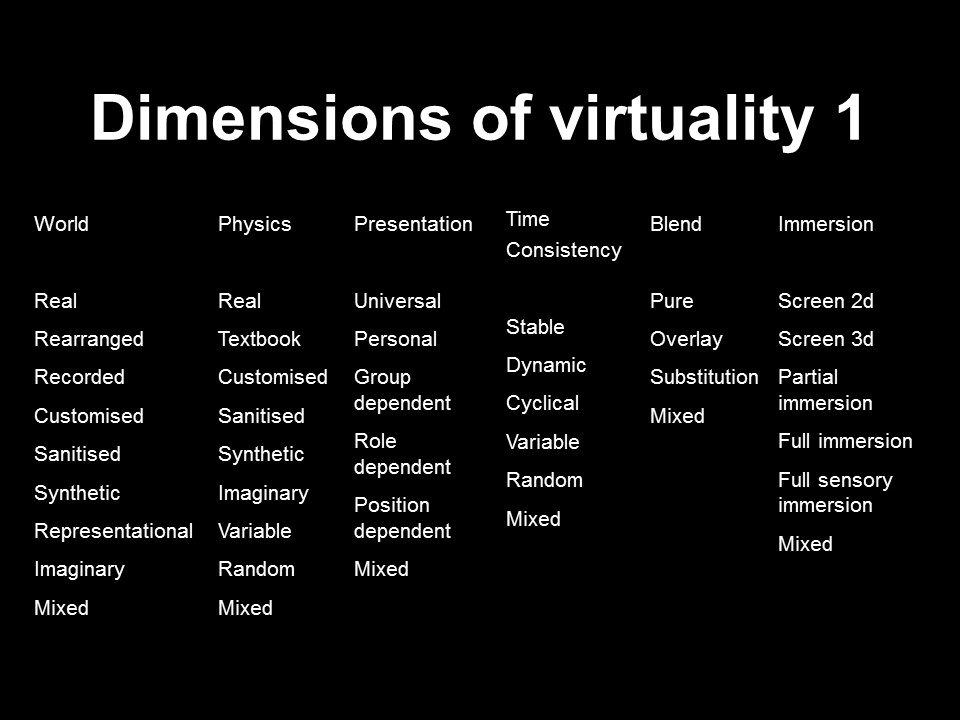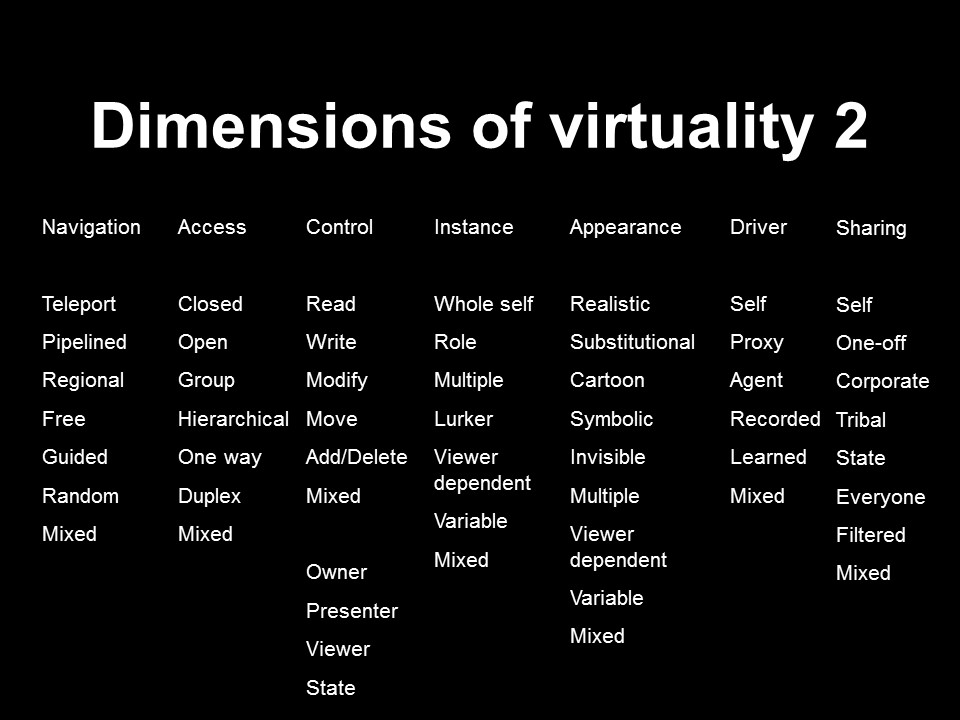My biggest ever error as a futurist was in 1991, just before I first played with VR on a Virtuality machine, when I predicted that VR would overtake TV as a form of recreation by 2000. It seemed obvious that it would. I estimated the approximate resolutions needed to make things sufficiently acceptable, and derived the computing power to fill a typical display with the virtual components a viewer would see at a time, then estimated how long that would take to arrive. I got 1998, and allowed a couple of further years for the market to take off enormously.
Before moving on, it’s worth looking at some of the reasons I got it wrong. First, computers did get better that quickly, but most of the increased power and memory was wasted by increasingly inefficient software practices. That has continued to be the case ever since. Secondly, I had assumed far too fast market take-up, but in my defence, that was my first ever project in futurology. Thirdly – and this wasn’t predictable so not my fault – Corning was sued for problems allegedly caused by their breast implants. The fact that the case was highly dubious and demanded enormous compensation for something Corning may well not have been the cause of must have absolutely terrified corporate lawyers all over the world. A few pieces of evidence were emerging that people using VR had become disoriented and one or two have minor accidents, while a few others felt eye strain. Any lawyer with a three digit IQ would have considered it extremely likely that there might be huge class actions against anyone developing VR visors by no-win, no-fee companies on behalf of every future teenager that developed a squint, regardless of whether it was caused by VR or any other cause. In my view, that probably delayed visors by decades, while poor software practices probably delayed the technological capability by a decade too. We have since seen some VR and AR appear, and it is far higher quality than I assumed was needed when I made my prediction and calculations, so I certainly have to accept that I was 100% wrong on the appeal and and market uptake rate. It is worth remembering this analysis when looking at potential future tech and markets. I was in the front edge of IT research but still managed to be very wrong.
Moving on, we’re seeing endless citation of the term ‘Metaverse’, of which Wikipedia says :
the word “Metaverse” is made up of the prefix “meta” and the stem “verse”; the term is typically used to describe the concept of a future iteration of the internet, made up of persistent, shared, 3D virtual spaces linked into a perceived virtual universe.
It’s nice Wikipedia is still a credible source of information for those things that have no possible political angle. It isn’t all biased.
Hang on. This ‘metaverse’ represents such a blinkered, limited vision of the future I am astonished it has been given the dignity of a name.
Internet? Persistant? Shared? 3d? Virtual? Spaces? That makes the metaverse on of 250 billion variations available.
We used to use the term ‘cyberspace’ to describe the notional space that existed inside the IT. Nothing in our understanding of cyberspace ever limited that virtual ‘universe’ to any of those words. The IT industry knew 25 years ago that combining virtual worlds with the real world would one day be a lucrative market area, and that ‘augmented reality’ as it is now known, would sit alongside VR as two of the headline markets, but the assumptions that they would be limited to persistant, shared or even 3D spaces was absent. We saw the opportunities in their full glory. If this Metaverse is meant to represent Newthink around cyberspace, it needs work. Lots of it. It sucks.
My 1998 paper Cyberspace: from order to chaos and back, won the best paper award when it was finally published in the Jan 2000 BT Engineering Journal. Its first key point is that there are essentially three domains, physical, mental and virtual. The physical domain is what we see all around us. The virtual domain, with all its countless variants that we used to loosely call cyberspace, is just 1s and 0s inside our IT (though analog signals or quantum processes could also form part of it). The mental domain is everything inside our minds – culture, memories, imagination and so on. Some people might add a 4th, a spiritual domain. As a techie, I acknowledge its existence (which obviously doesn’t depend on the existence of any gods – atheists can still have spiritual experiences), but the only parts of it that can be fabricated also exist in the mental domain. We can’t manufacture a spirit, just images or sculptures of how we might imagine one
Many things exist solely in one of the domains. A pebble that has never been seen exists solely in the physical world. A childhood memory exists purely in mental space. The virtual world models used by robots exists only in cyberspace. However, most market value exists where the domains meet. So there is huge value where physical meets mental. Objects become valuable because people want them; a filing cabinet is valuable because it physically implements a mental idea, a pencil because it lets is write an idea down. Where mental meets virtual, we see that stories become valuable when someone writes a book or makes a film, computer games and VR create value by letting us see and interact with virtual things. Augmented reality tries to combine all three, overlaying mental concepts onto the physical world as it appears on our visor, mapping both virtual objects and physical world sensor data onto virtual objects and letting us physically interact with physical things via virtual intermediation. I’ve often said that the enormously valuable world wide web resulted from convergence of computing and telecomms, but augmented reality will be vastly bigger market, because it results from convergence of the entire physical, mental and virtual domains. There’s gold in them there boundaries, but it’s also worth noting that we have only scratched the very surface of the virtual domain so far and much of value might lie withing it, as well as at the boundaries, even if much is only accessible to our AI and machines.
The Metaverse as described above does allow some of this and will be valuable as far as it goes. However, it excludes almost all potential realizations of this convergence and their potential markets.
Sure, persistence is useful, but so is transience, volatility. Shared is valuable but so is private, so is corporate. And so on. When we look at the full scope of convergence, it is helpful to consider dimensions, i.e the ways in which you can vary things. A mathematician typically chooses picks dimensions that are orthogonal, that can all be varied independently of each other, such as height, width, depth, colour, temperature, price.
Here are two diagrams from my paper:


I listed several potential variants of 14 dimensions and each option in each dimension can be used with any option from each other, 250 billion combos. But I didn’t run out of dimensions to include or even variants within them. I ran out of space. For example, I didn’t list the communications dimension. It could use the internet, or a global superhighway, or a mobile phone network, a satellite network, a mesh, sponge, ad-hoc, peer to peer or hybrid network, or letters, or CD in the post, etc etc. I didn’t list the operating system dimension, many options again. Or the display dimension – visor, phone screen, TV, computer monitor, visor, goggles, active contact lenses. Or style of user interface. Or who pays and all the variant business models. Or who chooses, you, the AI, the provider, government, a distributed conscience system… I could go on and on. I also overlooked many key variants (e.g. presentation via brail, or haptics, or active skin stimulation) and almost certainly still am.
If there are 25 useful dimensions (may be many more), and 10 variants in each one, then there are at least 10^25 potential ways in which they can be combined. 10 million billion billion. That makes 250 billion look like a drop in the ocean. What about our Metaverse? ‘Shared’ is only one tenth of the sharing possibilities. ‘Internet’ is one tenth of the network infrastructure possibilities. ‘Persistent’ is only one tenth of the time consistency possibilities. ‘3D’ is only one tenth of the immersion possibilities. ‘Virtual spaces’ are only one tenth of their dimension once we start to account for all the different kinds of AI and robots and machines that will also interact with virtual universes. Even the word ‘linked’ is only a tenth of a connectivity dimension and ‘perceived’ is one tenth of the potential there too. Is a tree perceived by an AI or robot that isn’t conscious? ‘Universe’? Why not multiverse, subverse, hyperverse, hybriverse or whatever? Now I’m just making words up for things that don’t exist yet, but could and maybe will. With just those 8 dubious words in its wikipedia definition needlessly limiting it to tiny fractions of the potential options, metaverse already limits itself to 1 100,000,000 of the potential market and reading between the lines, almost certainly adds many more zeros onto that via the many unspecified dimensions.
So you see why I’m annoyed at this suddenly fashionable term ‘metaverse’.
But let’s quickly look at that 10^25 figure. If a software engineer was told to write a package that would allow businesses or individuals or governments to enable virtuality with all these dimensions, how long would it take to try every single one just for an instant to make sure it works? If a million software engineers could somehow collaborate and get loads of AI to help them, with unlimited computing power, maybe they could explore a million every second. At one million every second, it would take 10 billion billion seconds to explore them all. 300 billion years, 23 times the age of the universe.
Cyberspace is big, very big. It cannot ever be fully explored. Of course we should try to spot the most valuable combinations and most lucrative potential markets. But the Metaverse blindfolds and deafens us and ties our hands and feet together before we start.






